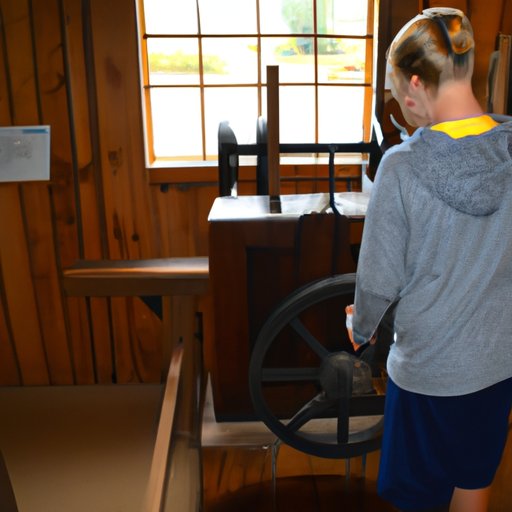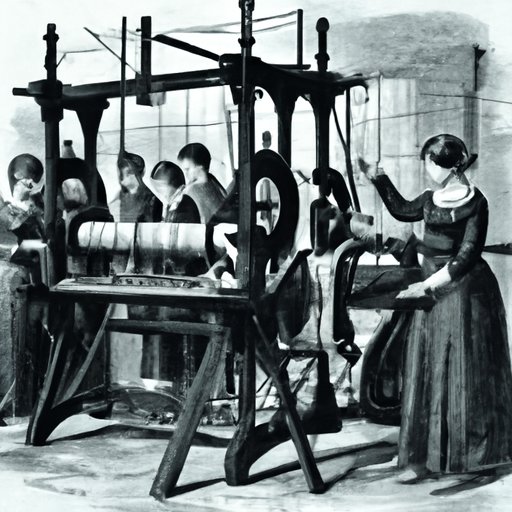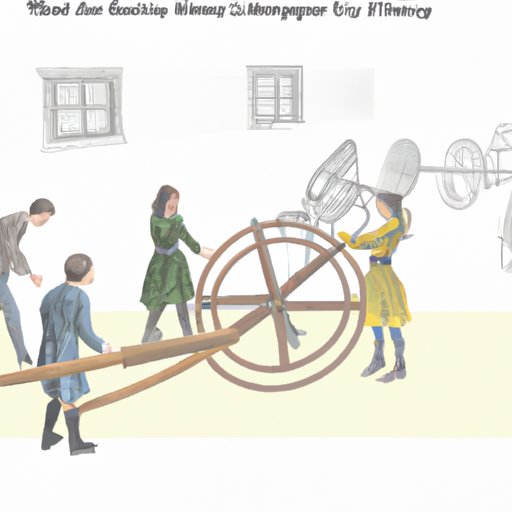Introduction
The spinning jenny is a revolutionary device that changed the face of the textile industry in the 18th century. It was invented by British carpenter James Hargreaves in 1764 and played a major role in the Industrial Revolution. The spinning jenny is a mechanical spindle used to spin yarn from fibers such as wool or cotton. It allowed for a faster and more efficient way to produce yarn than traditional hand spinning methods, increasing textile production and leading to a surge in economic growth.

Exploring the Historical Context of the Invention of the Spinning Jenny
The invention of the spinning jenny came at a time when the Industrial Revolution had just begun to take hold in Europe. The Industrial Revolution marked a period of rapid technological advancement and economic growth, spurred by innovations in manufacturing, transportation, and communication. In the late 18th century, many inventors sought to find new ways to increase productivity and profits, leading to the development of various labor-saving machines. Among them was James Hargreaves, who created the spinning jenny.
James Hargreaves was born in Lancashire, England in 1720. He was a weaver and carpenter by trade, and he had a passion for inventing new tools and machines. He is best known for his invention of the spinning jenny, which he developed in 1764. According to legend, Hargreaves was inspired to create the machine after watching his daughter, Jenny, spinning yarn with multiple spindles.
Investigating the Motivations Behind the Development of the Spinning Jenny
Prior to the invention of the spinning jenny, the process of spinning yarn was slow and labor intensive. It usually involved a single spindle operated by one person, and it could take days or even weeks to produce enough yarn for a single garment. The need for a faster and more efficient way to spin yarn was clear, and this was the primary motivation behind the development of the spinning jenny.
In addition to the need for speed, there was also a desire to increase textile production. The invention of the spinning jenny made it possible to spin more yarn in less time, allowing for greater production of cloth and other textiles. This led to the creation of larger factories and increased demand for raw materials like wool and cotton, further contributing to the growth of the Industrial Revolution.

Examining How the Spinning Jenny Revolutionized the Textile Industry
The spinning jenny was an immediate success and quickly revolutionized the textile industry. With the invention of the machine, it became possible to produce more yarn in less time, leading to a dramatic increase in production. By some estimates, the spinning jenny could produce up to eight times more yarn than a traditional hand spindle.
The invention of the spinning jenny also led to a decrease in labor needed to produce yarn. Instead of requiring one person to operate a single spindle, the spinning jenny could be operated by a single person using multiple spindles. This allowed for greater efficiency and cost savings, as fewer people were needed to produce the same amount of yarn.

Analyzing the Impact of the Spinning Jenny on Society
The invention of the spinning jenny had a profound impact on society. On a macro level, it helped to fuel the Industrial Revolution and bring about economic growth. The increase in textile production led to higher profits for investors, while the decrease in labor requirements meant lower wages for workers. This resulted in a shift in wealth from the working class to the upper classes.
On a micro level, the invention of the spinning jenny also had a positive impact on society. The increased production of yarn created new job opportunities, allowing people to earn a living and support their families. In addition, the proliferation of the spinning jenny meant that more people had access to affordable clothing, improving their quality of life.
Uncovering the Role of Technology in the Invention of the Spinning Jenny
The invention of the spinning jenny was made possible by advances in mechanical technology. This allowed for the development of new processes, such as the use of multiple spindles, which greatly increased efficiency and productivity. The invention of the spinning jenny also demonstrated the power of innovation, showing that simple ideas can have far-reaching consequences.
Understanding the Economic Implications of the Spinning Jenny
The invention of the spinning jenny had significant economic implications. For investors, the increased production of yarn meant higher profits, while for workers, the decreased labor requirements meant higher wages. This led to a rise in the standard of living for many people, as they were able to afford better food, housing, and clothing.
The invention of the spinning jenny also had global economic implications. The increased production of textiles led to a surge in exports, as countries began to sell their goods abroad. This opened up new markets and increased foreign investment, further boosting the world economy.

Discussing the Cultural Significance of the Spinning Jenny
The invention of the spinning jenny was not only a technological breakthrough, but also a symbol of progress and technological advancement. It represented a new era of innovation and creativity, and it helped to shape the modern world. The spinning jenny also served as a catalyst for social change, paving the way for further advancements in technology and industry.
Conclusion
The invention of the spinning jenny revolutionized the textile industry and had a profound impact on society. It was driven by a need for speed and a desire to increase textile production, and it led to a dramatic increase in yarn production and a decrease in labor requirements. The invention of the spinning jenny also had a positive effect on the economy, creating new job opportunities and increasing wages for workers. Finally, the spinning jenny was a symbol of progress and technological advancement, and it served as a catalyst for social change.
The invention of the spinning jenny was a pivotal moment in history, and its impact is still felt today. It revolutionized the textile industry and ushered in a new era of innovation and creativity. Without the spinning jenny, it is likely that the Industrial Revolution would have taken a much different course. For this reason, the spinning jenny will always be remembered as a revolutionary device that changed the face of the textile industry.
(Note: Is this article not meeting your expectations? Do you have knowledge or insights to share? Unlock new opportunities and expand your reach by joining our authors team. Click Registration to join us and share your expertise with our readers.)
